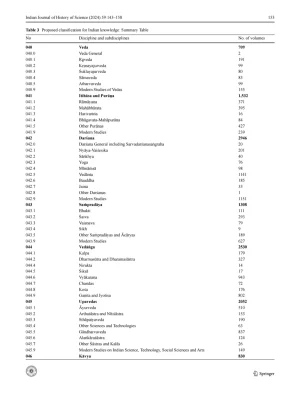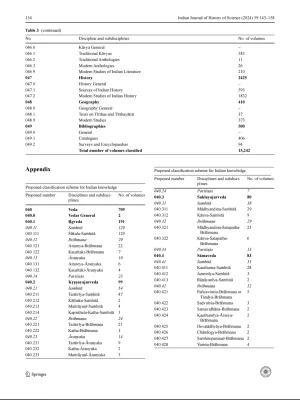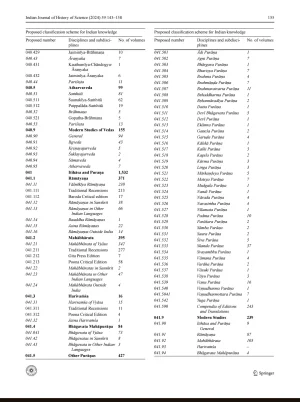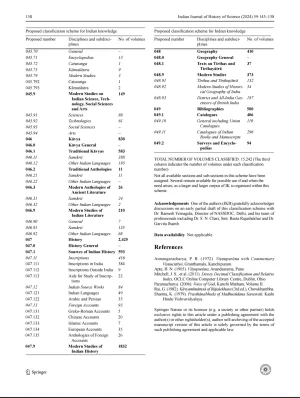- Joined
- Jul 8, 2024
- Messages
- 942
- Likes
- 1,758
Locating Indian knowledge in modern libraries: Incorporating the traditional classifcation of knowledge in India
Historically, Indian Knowledge, has been classifed into Aṣṭādaśa-vidyāsthānas (अषटदशविदयासथान), eighteen abodes of knowledge. This classifcation scheme assigns an appropriate place for all components of Indian knowledge in a consistent
system. In modern libraries, based mainly on the Dewey Decimal Classifcation (DDC), there is no natural place for the corpus of Indian Knowledge (IK), and diferent components of IK get split over widely separate diverse classes. In this article, we describe India’s traditional classifcation of knowledge and propose a national modifcation of the DDC to incorporate the former. The proposed scheme shall ensure that the diverse corpora of IK are compactly brought together in Indian libraries. This shall help the students and scholars appreciate the breadth and depth of IK and also the intercon-nectedness of its diferent components. It is impossible to understand the history of any element of IK, including Indian
Sciences and Technologies, without comprehending the interconnectedness of the entire corpus.
Introduction
The National Education Policy (NEP), adopted by the Government of India in 2020, seeks to make Indian Knowledge (IK) an essential and integral part of both education and research in India. An intensive and wide-ranging efort is underway to introduce components of Indian Knowledge in
the curricula at all levels of education. New textbooks are being written to conform to the new curricula. Numerous projects have been granted to research diferent aspects of Indian Knowledge. Hundreds, perhaps thousands, of teach-
ers and scholars are involved in this efort. The Indian academia is abuzz with this new emphasis on learning, teaching, interpreting and advancing Indian Knowledge and applying it in diferent domains.
1.1 But IK is not visible in the libraries Yet, any scholar or student walking into an Indian library is
unlikely to get any idea of the depth and breadth of Indian Knowledge and would be at a loss to understand what all the activities surrounding this system of knowledge are about. This failure of the Indian libraries to showcase Indian Knowledge in any signifcant manner is because of the following two reasons:
First, since Indian Knowledge has formed no part of modern Indian education and has occupied barely a small niche in academic research until now, most Indian libraries, except a few that specialize in diferent aspects of Indian
knowledge, art, or culture, have only a few titles dealing with Indian Knowledge. It should be hoped that with the new efort to seriously introduce Indian Knowledge as an integral part of Indian education and research, Indian libraries at all levels, from the school and town library upward,
shall be encouraged and facilitated to acquire at least the basic texts of Indian Knowledge.
Second, libraries in India follow the international
Dewey Decimal Classifcation (DDC) system in its current wenty-third edition (Mitchell et al., 2011), or some version of it, to classify their acquisitions, and that classifcation then decides the shelves where these would be placed in the library. This classifcation system pays no attention to the traditional classifcation of knowledge in India and is designed for modern, largely Western, knowledge. Therfore, it tends to disperse books of IK across the whole library and, in a way, hides these in a mass of unrelated and diverse
material, thus making it impossible for a scholar to comprehend his particular subject within the overall scheme of IK and appreciate the essential interconnectedness between diferent components of it.
Historically, Indian Knowledge, has been classifed into Aṣṭādaśa-vidyāsthānas (अषटदशविदयासथान), eighteen abodes of knowledge. This classifcation scheme assigns an appropriate place for all components of Indian knowledge in a consistent
system. In modern libraries, based mainly on the Dewey Decimal Classifcation (DDC), there is no natural place for the corpus of Indian Knowledge (IK), and diferent components of IK get split over widely separate diverse classes. In this article, we describe India’s traditional classifcation of knowledge and propose a national modifcation of the DDC to incorporate the former. The proposed scheme shall ensure that the diverse corpora of IK are compactly brought together in Indian libraries. This shall help the students and scholars appreciate the breadth and depth of IK and also the intercon-nectedness of its diferent components. It is impossible to understand the history of any element of IK, including Indian
Sciences and Technologies, without comprehending the interconnectedness of the entire corpus.
Introduction
The National Education Policy (NEP), adopted by the Government of India in 2020, seeks to make Indian Knowledge (IK) an essential and integral part of both education and research in India. An intensive and wide-ranging efort is underway to introduce components of Indian Knowledge in
the curricula at all levels of education. New textbooks are being written to conform to the new curricula. Numerous projects have been granted to research diferent aspects of Indian Knowledge. Hundreds, perhaps thousands, of teach-
ers and scholars are involved in this efort. The Indian academia is abuzz with this new emphasis on learning, teaching, interpreting and advancing Indian Knowledge and applying it in diferent domains.
1.1 But IK is not visible in the libraries Yet, any scholar or student walking into an Indian library is
unlikely to get any idea of the depth and breadth of Indian Knowledge and would be at a loss to understand what all the activities surrounding this system of knowledge are about. This failure of the Indian libraries to showcase Indian Knowledge in any signifcant manner is because of the following two reasons:
First, since Indian Knowledge has formed no part of modern Indian education and has occupied barely a small niche in academic research until now, most Indian libraries, except a few that specialize in diferent aspects of Indian
knowledge, art, or culture, have only a few titles dealing with Indian Knowledge. It should be hoped that with the new efort to seriously introduce Indian Knowledge as an integral part of Indian education and research, Indian libraries at all levels, from the school and town library upward,
shall be encouraged and facilitated to acquire at least the basic texts of Indian Knowledge.
Second, libraries in India follow the international
Dewey Decimal Classifcation (DDC) system in its current wenty-third edition (Mitchell et al., 2011), or some version of it, to classify their acquisitions, and that classifcation then decides the shelves where these would be placed in the library. This classifcation system pays no attention to the traditional classifcation of knowledge in India and is designed for modern, largely Western, knowledge. Therfore, it tends to disperse books of IK across the whole library and, in a way, hides these in a mass of unrelated and diverse
material, thus making it impossible for a scholar to comprehend his particular subject within the overall scheme of IK and appreciate the essential interconnectedness between diferent components of it.







